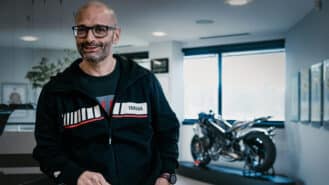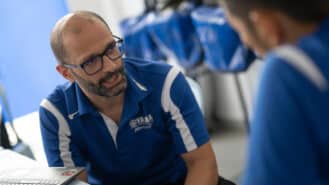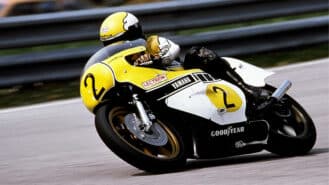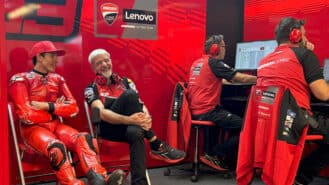Mystery 1: Yamaha’s qualifying capers
The world of MotoGP holds thousands of mysteries, many of which are way beyond my ken. But there is something that has bothered me for the last couple of seasons, with ne’er a reasonable explanation offered by anyone in the paddock: why does everyone gift the racetrack to Jorge Lorenzo at the start of qualifying?

You could set your watch by Lorenzo’s first QP exit: off he goes, ahead of everyone and chased by no-one, with the racetrack all to himself, just the way he likes it.
How does this happen? Why do his rivals let him do exactly what he wants? Why do none of them accelerate out of pitlane sucking up his exhaust fumes, using him to lower their own lap times, perhaps even learning something, perhaps even showing him a wheel to upset his equilibrium? His rivals should do anything and everything to ruffle his self-styled Buddhist calm because winning isn’t merely about being faster, it’s also about being cleverer.

Andrea Dovizioso offers this explanation. “It is impossible to be quicker than Jorge on the first lap because he is so fast on new tyres.”
But it wasn’t always thus. Lorenzo didn’t used to be fast out of the gate. Lorenzo learned this risky trick from Casey Stoner, who used it to devastating effect, because he knew it was the only way to compete with the Australian.
A few winters ago Lorenzo worked hard at this: storming out of the pits with new tyres and a full tank to learn the skill which has become the foundation of his success: pole position followed by the same on-the-edge tilt into the first corners of the race.
At Motegi someone did for the first time try to rattle him in Q2. And the man who did the rattling was team-mate and title-rival Valentino Rossi.
“It’s all very clandestine,” says Rossi’s mechanic Alex Briggs. “At the start of qualifying both our riders are sat in the box, looking at each other, waiting for whoever makes the first move.”
Motegi was different because Lorenzo had opted for a three-tyre strategy in the 15-minute session, so he couldn’t wait for the right moment to outfox Rossi. Instead he raced out of the pits with Rossi right behind him, and on their second flying lap the Italian was faster.

In the post-qualifying press conference Lorenzo intimated he wasn’t happy that Rossi had profited by following him. Meanwhile Rossi sat alongside, grinning like a naughty schoolboy. Bingo, he had got to his title rival.
But how come he hadn’t tried this before? Dovizioso again: “Valentino followed him this time, so it won’t happen next time, because Jorge won’t go out in front.”
So maybe this was Rossi the arch-strategist at work. He has saved this little disruption tactic for when it matters most, to destabilise his rival at the critical championship moment.
Mystery 2: Dani’s front tyre
During the race Dorna’s slow-motion camera footage revealed that the two Yamahas were chewing up their front rain tyres faster than Dani Pedrosa’s Honda. How come?
Like anything in racing it was a combination of factors. Pedrosa is very light, which makes a difference in deceleration, but possibly more important was how the different men and their machines looked after their tyres.
Lorenzo tore away at the start, attempting his usual disappearing trick. This was a huge mistake. After the race he admitted he didn’t win because, “the track dried up… If I’d known that was going to happen, I wouldn’t have pushed so hard at the start.”

But how could he not know the track was going to dry up? The heavy morning rain was long gone, so once again Lorenzo failed to make the most of the circumstances.
After the race Pedrosa had the best front tyre, partly because he looked after it. He adjusted his riding technique to minimise tyre stress during braking and when he rode away from corners he veered onto the damper parts of the track to cool his tyres.
Honda’s RC213V also played its part. Motegi demands so much from brakes that larger diameter 340mm discs are compulsory for the Japanese GP, but even so most factories struggled with overheating. Ducati, Suzuki and Yamaha all used air ducts to cool the brakes, but not Honda. Brembo technicians believe the RCV’s brakes run cooler because the bike has better braking balance and a very effective engine-braking system – two more factors that saved Pedrosa’s front tyre.
Braking and corner entry are now hugely important in MotoGP, so it was no surprise to see the layout of Yamaha’s 2016 YZR0-M1 prototype, ridden at Motegi by wild card Katsuyuki Nakasuga. In its search for better braking balance Yamaha has a fuel tank that’s about three-feet long. The tank extends all the way from the rear shock into the seat hump, with the filler cap mounted in the hump; in other words shifting the fuel load as far back as possible.

Mystery 3: What about the air ambulance?
I’m not sure I have an answer to this one.
MotoGP has very stringent safety rules. The series only visits the safest tracks and has an immense medical back-up procedure, plus regulations that include recommendations that the nearest hospital must be no further away than 20 minutes by air or 45 minutes by road.
Motegi is situated in mountainous countryside 65 miles north east of Tokyo, with the nearest hospital an hour away by car. Hence the need for two air ambulances as part of the event’s contract with Dorna.
Alex de Angelis had a freak accident during Saturday’s FP4 session, suffering serious injuries that included a potentially disastrous intracranial hematoma (brain bleed). Speed of treatment in dealing with such a trauma can be a matter of life or death.
The Ioda Aprilia MotoGP rider was helicoptered to Dokkyoidai hospital, about 25 miles away, a trip that takes around 20 minutes, including take-off, landing and a cruising speed of 100 knots (115mph/185kph).

The de Angelis crash was an unlucky freak of an accident but in fact the former 250 GP winner was lucky to crash when he did. If he had fallen on Sunday he may have had to endure a considerably lengthier road trip to Dokkyoidai hospital because the helicopter was fogbound.
Race-day warm-up was delayed due to the lack of air-med facilities and the racing might have gone the same way, threatening the all-important TV schedule.
You may remember Motegi has been here before. In 2013 the circuit was blanketed in thick fog throughout Friday and most of Saturday, thus the helicopter was unable to fly, so MotoGP’s full-time medical director and the local chief medical officer refused permission for practice to get underway. Finally on Saturday afternoon the fog cleared and the event was saved the embarrassment (and commercial damage, for all involved) of cancellation.
After that close call, MotoGP’s medical director demanded changes that would make road-ambulance transport viable. The upgrades – improved trackside medical facilities and ambulances – were ready for this year, which is why Race Direction gave the greenlight for the warm-up sessions, despite the helicopter remaining grounded.
But does all this add up? When warm-up got underway, an explanatory press release stated that Race Direction was happy to go ahead thanks to the updated medical facilities and the promises of police co-operation to reduce road travel time to “no more than 50 minutes,” which exceeds its own recommendation by five minutes.

So, if de Angelis had crashed while the helicopter was grounded on Sunday he would have taken half an hour longer to reach hospital by ambulance. In cases of intracranial hematomas and brain swelling, 30 minutes can make the difference between full recovery or lifelong brain damage or even death, because efforts to stem a brain bleed or reduce swelling cannot be made until the patient undergoes a full operation at hospital.
The roads from Motegi to the Dokkyoidai hospital are mostly narrow and very twisty and very up and down; great for bike riding, but far from ideal for an ambulance carrying a patient with a serious brain injury. Even with a police escort, an ambulance would struggle to average more than 40mph along these roads until it reached the final part of its journey on the Kita-Kanto Expressway.
Surely, Dorna needs to have a further look at the Motegi medical situation, or are they more concerned with keeping TV moguls, sponsors and advertisers happy?












